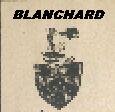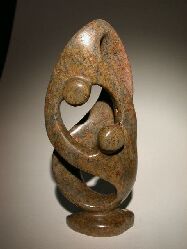 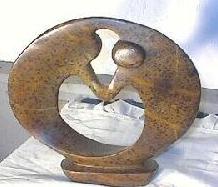
African Hand-Carved Stone Art
Shona artists and artists from other areas of South Africa carved these tribesmen, elephants and abstract
sculptures.
Most of the carvings are done by hand, without the benefit of power tools. The stones are finished
with a coating of wax.
Many of these carvings are signed by the artist.
Rapoko (soapstone) is the most common stone used in Shona carvings as it is in plentiful supply throughout
Zimbabwe. It is also a softer stone and does not require the use of power tools. The main color of Rapoko is brown,
but there can also be mixtures of grey and green colors throughout the stone. Rapoko is a favorite among the carvers
of Zimbabwe, who bring out the best in carvings from this stone. The detail achieved in the tribesmen carvings is exquisite.
Verdite is a semi-precious green stone of exceptional beauty, over 3.5 billion years old. There are
only two deposits in the world, Southern Africa and Zimbabwe. The Zimbabwe deposit is of particularly high quality because
of its hardness and beautiful variations of color. Verdite occurs in a variety of patterns and shades, ranging from
Golden - Brown to rich Emerald Green and Blue. Constituents of Verdite include: Corundum, Albite, Chromium and Fuchite.
Verdite has a Mohs' hardness of 3.5 - 4. Modern equipment such as die grinders with tungsten carbide burrs are used
to carve out these sculptures
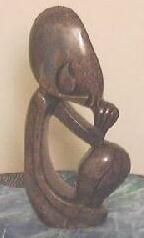
AFRICAN MAGIC
What do New York's Museum of Modem Art, Queen Elizabeth II, the Rockefellers and the Rothschilds have in common ? They all
own remarkable semi-abstract sculptures carved by the Shona, Zimbabwe's largest tribe. Picasso was an admirer of early Shona
sculpture; now evidence is surfacing that he was influenced by it, too.
Astonishingly, the sculptures made today are not very different from those made more than 1000 years ago; they achieve the
same delicate balance and employ similarly masterful lines. After quarrying the raw stone with hatchets, the sculptors use
crude chisels to "release" the spirit trapped in the stone. Next, they polish the stone with sand and beeswax. Finally, they
heat it on a fire to bring out the brilliant colors (Town & Country, January 1997).
The Shona School has been developing since the 1960's and is, according to NEWSWEEK magazine, probably the most important
art form to have emerged from Africa during the 20th century. (Shona art commands international acclaim and is well represented
in travelling and permanent exhibitions from Tokyo to London and New York).
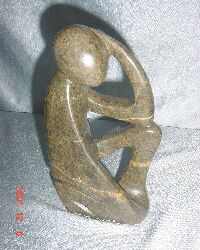

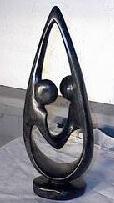
|
